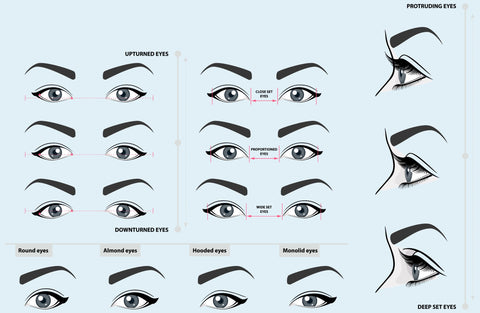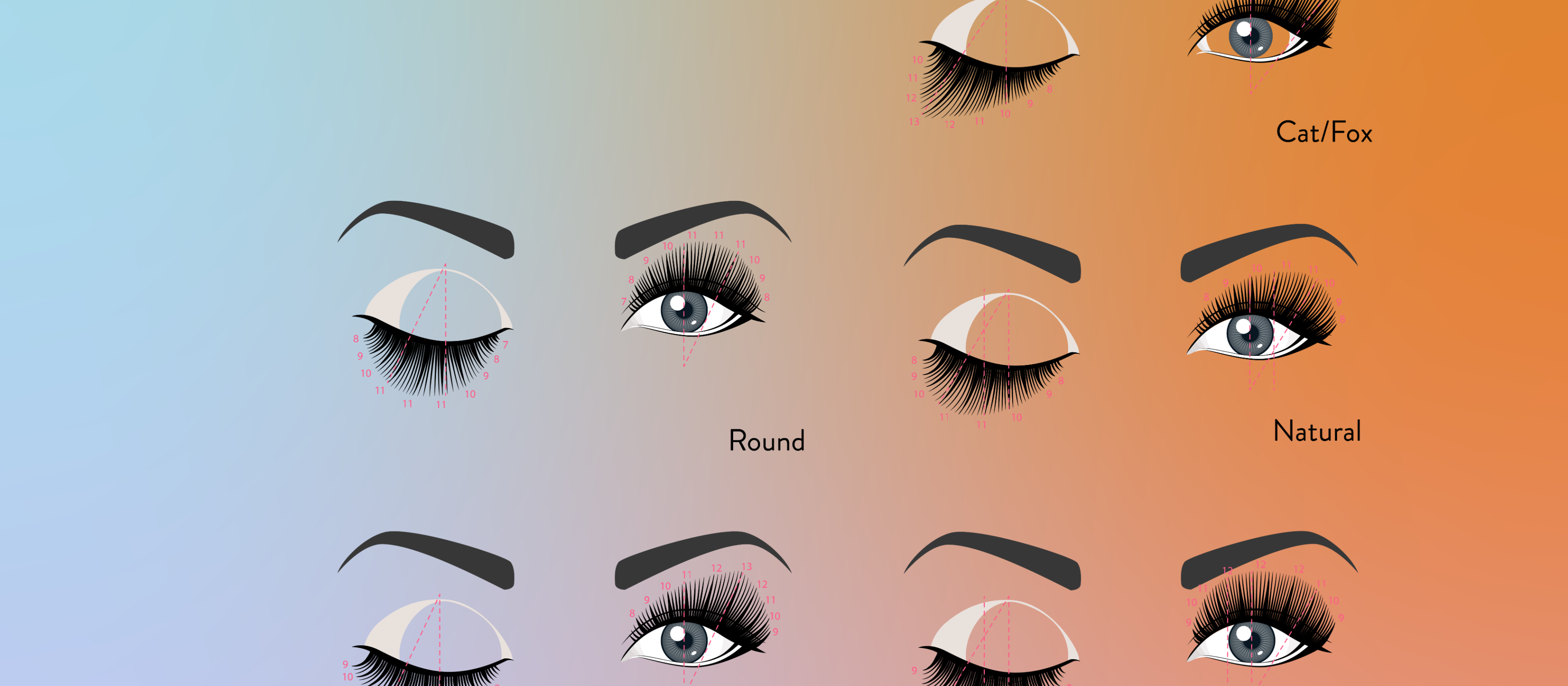Free tracked 24H UK shipping on all orders over £50
Imagine walking into a room with a fabulous pair of eyelash extensions that not only look natural but also feel comfortable and long-lasting. That's the magic of flawless lash mapping in eyelash extension application, an integral part of the process that significantly influences the final outcome.
The importance of lash mapping is often underestimated in the beauty industry. However, it serves as the blueprint for the perfect set of eyelash extensions, dictating the size, length, curl, and placement of each extension. Just like an architect wouldn't build a house without a plan, a lash technician should never apply extensions without a meticulously crafted lash map. This crucial step helps to tailor the extensions to each client's unique eye shape and natural lashes, enhancing the overall look and longevity of the extensions.
In this blog post, we'll take you on a journey through the art and science of lash mapping. We will start by explaining what lash mapping is and why it plays such a pivotal role in eyelash extension application. Then, we'll delve into different lash mapping techniques and styles used by experts, followed by a discussion on how precise lash mapping contributes to achieving symmetry and balance.
We'll share some valuable tips and tricks from seasoned lash technicians, including advice on client consultations and using various mapping tools. Finally, we'll provide a practical guide on creating and adapting lash maps to suit different eye shapes and styles.
Whether you're a budding lash artist looking to hone your skills or an experienced technician seeking to refine your approach, this comprehensive guide aims to equip you with the knowledge and confidence to create flawless lash maps. So, let's get started on this exciting journey to achieving stunning, long-lasting eyelash extensions!
What is Lash Mapping?
Lash mapping is a pre-application process that involves sketching out a plan for eyelash extension placement on a client's natural lashes. It provides a clear and precise guide for technicians to follow, ensuring each lash extension is placed in the most flattering and appropriate position.
The purpose of creating a lash map before starting the application process is twofold. First, it allows the technician to visualise the desired outcome and strategise the best approach to achieve it. This strategy includes determining the ideal length, thickness, and curl of the extensions to accentuate the client's unique eye shape. Second, having a detailed lash map helps to maintain consistency and balance throughout the application process, promoting an even distribution of extensions and preventing any potential clumping or overcrowding of lashes.
Lash technicians employ various mapping techniques and styles to create customised looks that cater to their clients' preferences and natural features. A popular mapping style is the 'open eye' technique, which involves applying longer extensions in the middle of the eye to create an illusion of wider, more awake eyes. On the other hand, the 'cat-eye' style uses longer extensions at the outer corners of the eyes, adding a sultry, almond-shaped effect. There are also more intricate styles like the 'Kim K' and 'Russian Volume,' which involve varying lengths and volumes to create a dramatic, fluffy appearance.
It's important to note that the choice of lash mapping style isn't solely dependent on aesthetic preference. It should also consider the health and condition of the client's natural lashes. For instance, if a client has weak or sparse natural lashes, a technician might opt for a 'Natural' mapping style that uses lighter, shorter extensions to prevent unnecessary strain on the natural lashes.
Ultimately, the art of lash mapping is a process that calls for a keen eye, steady hand, and a deep understanding of beauty aesthetics.
Why Lash Mapping is Essential for Flawless Eyelash Extensions
While lash mapping might sound like a complex science, its fundamental principle is quite straightforward and undeniably crucial in the art of eyelash extension application. Let's start by addressing how lash mapping tailors the extension placement to each client's unique eye shape and natural lashes.
Customising Extension Placement
Each of us is blessed with a unique eye shape and distinct set of natural lashes. This diversity requires a personalised approach when it comes to applying eyelash extensions. Lash mapping serves as the blueprint for this customisation. By meticulously studying the client's eyes and natural lashes, a lash technician can create a 'map' that outlines where to place each extension. This map accounts for factors like the length, thickness, and curl of the natural lashes, as well as the curvature and width of the eyelid. By adhering to this map during application, technicians ensure that each extension enhances the client's natural beauty rather than overpowering or distorting it.
Achieving Symmetry and Balance
Next, let's consider the role of lash mapping in achieving symmetry and balance. Just like an architect relies on blueprints to construct a balanced and symmetrical building, lash technicians depend on lash maps to create harmonious lash lines. Precise lash mapping helps identify the optimal points for placing extensions, ensuring an even distribution across both eyes. The result? A pair of perfectly balanced, symmetrical eyelashes that enhance the client's natural features while adding a touch of glamour.
Avoiding Potential Pitfalls
Finally, lash mapping is an invaluable guide that helps avoid potential pitfalls during the application process. For instance, placing too heavy extensions on weak or short natural lashes can lead to premature shedding or even damage the natural lashes. A detailed lash map can prevent such issues by specifying the appropriate length and weight of extensions for each part of the lash line. Moreover, it can guide technicians in avoiding overly cluttered looks or unnatural patterns, which may not suit the client's eye shape or desired look. Thus, a well-constructed lash map is like a trusted companion that steers you clear of potential missteps, ensuring a flawless finish every time.
From tailoring the extension placement to ensuring symmetry and balance, to steering clear of common pitfalls, lash mapping plays a pivotal role in eyelash extension application. It's not just a technique—it's an essential tool for unlocking the full potential of your lash game. In the next section, we will share some expert tips and tricks to help you master the art of flawless lash mapping. Stay tuned!
Expert Tips and Tricks for Flawless Lash Mapping
After delving into the importance of lash mapping in achieving a flawless eyelash extension application, you might be wondering - how can I master this skill? Well, it's your lucky day! In this section, we're going to take a journey through some expert tips and tricks that will take your lash mapping game to the next level.
Proper Consultation with Clients
First and foremost, it's essential to have a thorough consultation with your client. Understanding your client's desired look and expectations is the foundation of successful lash mapping. Ask them about their preferences on length, volume, and curl. Do they prefer a more natural look or are they after a dramatic, glamorous finish? This information will guide your lash mapping process and help ensure the final result aligns with their vision.
The Right Tools for the Job
Moving on, let's talk about tools. The right tools can make all the difference when it comes to creating a precise lash map. Under-eye patches, pens, and adhesive tape are all popular choices among lash technicians. These tools allow you to mark out where each size lash will go, helping to ensure a symmetrical and balanced look. Remember, practice makes perfect, so try out different tools and find what works best for you!
Accurate Measurement and Mapping Techniques
To create a flawless lash map, you'll need to accurately measure and mark the lash line. Start by measuring the width of your client's eye. This will help you determine the appropriate length and curl of the extensions. Then, mark out where each size lash will go, starting from the inner corner and working your way outwards. Remember, the goal is to enhance the client's natural eye shape, so be sure to adjust the map as needed.
In closing, mastering the art of lash mapping is a journey that begins with understanding your client's vision, using the right tools, and honing your measuring and mapping skills. These expert tips and tricks will set you on the path to success, helping you achieve flawless eyelash extension applications every time. So, ready to elevate your lash game? Let's get mapping!
How to Implement Lash Mapping in Eyelash Extension Application
You've mastered the theory, understood the significance of lash mapping, and gotten acquainted with all the necessary tools. Now, it's time to dive into the practical aspect: implementing lash mapping in your eyelash extension application process. This section will guide you through each step, providing expert tips for maintaining consistency, ensuring accuracy, and adapting the lash map to suit different eye shapes and styles.
A Step-by-Step Guide on Creating a Lash Map
Creating a lash map might seem daunting at first, but with patience and practice, you can become a pro. Start by cleaning the client's lashes thoroughly to remove any residue or makeup. Then, assess the client's natural eyelashes and eye shape. Use a marker pen to outline where each type of lash extension (according to length and curl) will be applied on the Under-eye patches. This outline serves as your blueprint throughout the application process.

Maintaining Consistency and Accuracy
The key to flawless lash extensions is consistency and accuracy, which are primarily achieved through careful planning and precision during the application. When applying the extensions, always refer back to your lash map. It will guide you on where to place each lash and which type to use. Additionally, regularly cross-checking your work against the lash map can help spot inconsistencies or inaccuracies early on.
Adapting the Lash Map for Different Eye Shapes and Styles
Every client has a unique eye shape and desired style, so it's important to adapt your lash map accordingly. Here are some tips for different eye shapes:

- Almond Eyes: Almond-shaped eyes are considered the most ideal shape for lash extensions. To enhance this shape, focus on creating a cat-eye effect by gradually increasing the length and volume of the lashes from the inner corner to the outer corner.
- Round Eyes: For round eyes, the goal is to elongate and open up the eyes. Place longer lashes towards the outer corners to create a lifted effect. Avoid using heavy, dense lashes on the inner corners, as it can make the eyes appear smaller.
- Hooded Eyes: Hooded eyes have a fold of skin that partially covers the eyelid, making the lash line less visible. To combat this, use shorter lashes on the inner corners and gradually increase the length towards the outer corners. This will help create the illusion of a more open and lifted eye.
- Close-Set Eyes: For clients with close-set eyes, the focus should be on creating the illusion of width. Place longer and fuller lashes on the outer corners to visually widen the eyes. Avoid using excessive length or volume on the inner corners, as it can make the eyes appear even closer together.
- Wide-Set Eyes: Wide-set eyes can be balanced out by placing longer lashes towards the inner corners. This will visually bring the eyes closer together. Avoid using excessive length or volume on the outer corners, as it can make the eyes appear wider.
Remember, these are just guidelines, and it's important to customise the lash map based on your client's preferences and natural features.
Implementing lash mapping in your eyelash extension application process is crucial for achieving flawless results. By accurately measuring and marking the lash line, maintaining consistency and accuracy, and adapting the lash map to suit different eye shapes and styles, you can enhance your client's natural beauty and create stunning lash looks. With practice and dedication, you'll become a lash mapping expert in no time. So, grab your tools, get mapping, and elevate your lash game!
